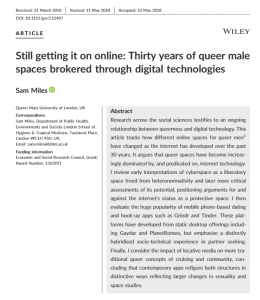
Our latest blog is by Dr Sam Miles, who discusses the recent publication of his academic article ‘Still getting it on online: Thirty years of queer male spaces brokered through digital technologies’ in the journal Geography Compass.
By way of introduction, I thought I’d borrow from my latest article to give you a snapshot of what I’ll be talking about in this blog post:
I call on contemporary scholarship to demonstrate how [mobile phone] platforms offer a way into answering larger cultural questions about cruising, queer social life, and space. I conclude that these locative digital media occupy a distinctive position in the history of queer technologies and signal a shift in how gay male online spaces are both conceptualised and experienced.
In the social sciences, theories of sex and sexuality have long been tied up in ideas of space and place. There are any number of examples we can think of, from the spaces of sex work and how these spaces are regulated or policed, to the rise (and more recently, fall) of the commercialised ‘gay village’ in the global north, which is often discussed in terms of its relations with economics and gentrification.
 Trying to better understand the relationship between sex and sexuality and space is important because beyond theoretical ideas, it has an impact on how a location might influence sexual identity, practices or safety. For example, healthcare interventions for sex workers might depend on a safe space accessible from their working space. Civil rights demonstrations or an LGBTQ pride parade in a repressive political environment can be read as a temporary ‘queering’ of the orthodoxy or regime by making space for sexual difference in streets normally controlled by the mainstream.
Trying to better understand the relationship between sex and sexuality and space is important because beyond theoretical ideas, it has an impact on how a location might influence sexual identity, practices or safety. For example, healthcare interventions for sex workers might depend on a safe space accessible from their working space. Civil rights demonstrations or an LGBTQ pride parade in a repressive political environment can be read as a temporary ‘queering’ of the orthodoxy or regime by making space for sexual difference in streets normally controlled by the mainstream.
My own research has focused on digital technology and sexual practices. I have been interviewing ‘MSM’ (men who have sex with men, including but not limited to gay and bisexual men) to learn more about how recent developments in technology mean that queer male space is not just physical, but virtual too.
 Geography Compass invited me to write an article for them reviewing the history of queer male online space. I think this topic is particularly fascinating is because the social sciences have long tracked physical queer spaces, and this research is widely known; less is known about how online platforms contribute to producing or re-making queer spaces. What I specialise in is locative media – by which I mean GPS enabled mobile phone apps – that are now very popular amongst MSM to network and meet others for social and/or sexual connection. These locative apps include Tinder, Grindr and Hornet, and have a huge user base around the world. Grindr alone counts nearly 4 million users per day.
Geography Compass invited me to write an article for them reviewing the history of queer male online space. I think this topic is particularly fascinating is because the social sciences have long tracked physical queer spaces, and this research is widely known; less is known about how online platforms contribute to producing or re-making queer spaces. What I specialise in is locative media – by which I mean GPS enabled mobile phone apps – that are now very popular amongst MSM to network and meet others for social and/or sexual connection. These locative apps include Tinder, Grindr and Hornet, and have a huge user base around the world. Grindr alone counts nearly 4 million users per day.
I argue that the development of mobile internet over the past decade, and the GPS abilities that are now built into even basic smartphones, strongly influence how men meet other men for relationships and sex. This in turn has an impact on ‘offline’ LGBTQ venues such as gay bars or cruising sites, as well as traditional understandings of ‘queer community’ and what that might mean. As I write in the article:
Male–male locative media can strengthen and extend social‐sexual networks, facilitating meetings with like‐minded men across a borough, district, or city. This is especially true among the users for whom a queer community is out of reach because of their isolation, whether familial, social, or geographical.
Of course, being connected to other sexual minorities through an app does not automatically constitute a community, but some users do report a sense of like-mindedness, even if this does not match up with the more established ways in which we define community.
 Beyond MSM populations specifically, this idea of technology redefining community, whether for better or worse (or indeed both!) is crucial to how we understand how technology mediates human behaviour. In a public health context, technology needs to be harnessed in ways which are alert to local conditions, whether that is in terms of unequal access to technology, or an affinity (or restriction) to certain kinds of communication device. At the same time, the widespread adoption of mobile phone technology – 5 billion people worldwide now have access to mobile phones – shows that digital technology ‘on the go’ will become ever more central to daily life. The job now is to extend research carried out on mobile digital technologies and sexualities to different populations to help us understand more about how these platforms will impact on social and sexual practices in the near and distant future.
Beyond MSM populations specifically, this idea of technology redefining community, whether for better or worse (or indeed both!) is crucial to how we understand how technology mediates human behaviour. In a public health context, technology needs to be harnessed in ways which are alert to local conditions, whether that is in terms of unequal access to technology, or an affinity (or restriction) to certain kinds of communication device. At the same time, the widespread adoption of mobile phone technology – 5 billion people worldwide now have access to mobile phones – shows that digital technology ‘on the go’ will become ever more central to daily life. The job now is to extend research carried out on mobile digital technologies and sexualities to different populations to help us understand more about how these platforms will impact on social and sexual practices in the near and distant future.
You can read Sam’s article here and follow him on Twitter here.

